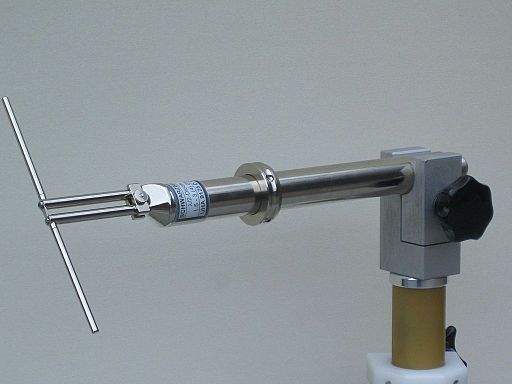A half-wave dipole antenna [1] is comprised of two quarter-wavelength conductors placed end to end. Its physical length is half the wavelength of the transmitted or received RF signal.
Use this calculator to determine the length of a half wave dipole from the frequency of operation.
Enter the frequency in MHz and the tool will compute the antenna length (L).
Example Calculation
For an operating frequency of 2450 MHz, The dipole length (L) is 2.29 inches or 5.82 centimeters.
Formula
The total length (L) of the dipole antenna in feet is calculated as:
L = 468 / f
where f is the frequency in MHz.
The length of each arm of the dipole
l = L/2
Background
What is a half wave dipole?
A half wave dipole is a type of antenna that consists of two conductors that are each quarter of a wavelength long. This antenna is often used in radio communication and is one of the most common types of antennas. It is called a dipole because it has two conductive elements.
The picture below shows a dipole antenna that operates from 1 GHz to 4 GHz.

Example Calculations
Let’s take a look at how the dimensions of a dipole antenna are calculated.
Every antenna is designed to operate at a certain frequency or equivalent wavelength.
If the frequency is specified then it can be entered directly into the calculator above.
For example, at a frequency of operation equal to 2450 MHz, the half wave dipole length (L) is 2.29 inches or 0.06 meters. The length of each conductor is 1.145 inches.
Instead of frequency, we might want to specify the wavelength of the antenna in meters.
A popular band of operation for amateur radio is the 70 cm band. Use this tool to convert from wavelength to frequency. In this case, the frequency is 428 MHz. Use this value of frequency in the calculator to compute the length of the half-wavelength dipole. In this case it is 1.09 feet or 33 centimeters.
As the frequency of operation decreases, the physical length of the antenna increases.
In the above calculation for the 70 cm band antenna, we can see that the length of the antenna is 33 cm which is approximately half the wavelength. This is consistent with the fact that it is a half-wave dipole antenna.
The reason it’s not exactly half wavelength (35 cm in this case) is because of the end effect* and a resulting multiplication by 0.95.
35*0.95 = 33 cm (which is what the computation gives us)
The actual formula for length (L) in feet of the half wave dipole is:
L = 492 / f
where f is the frequency in MHz.
Taking the end effect into account 492 * 0.95 ≈ 468.
* A practical rectilinear conductor will resonate when it is slightly less than a half-wave in length due to the end effect. End effect is due to a decrease in inductance and an increase in capacitance near the end of the conductor, which effectively lengthens the antenna.
This is from the book Fundamentals of Single Sideband via KB6NU’s Ham Radio Blog.
What is the gain of a half wave dipole antenna?
The gain of a half wave dipole antenna is 2.15 dBi. Units are dBi which stands for dB with respect to an isotropic radiator.
Antenna gain can also be specified as relative to a lossless half wave dipole. Units in this case are dBd. Also, the following conversion applies:
Gain (dBd) = Gain (dBi) – 2.15
Some manufacturers specify the gain of their antennas relative to that of a half wave dipole. It’s important to check the specifications and units in the data sheet to confirm.
A dipole does not have to be half wavelength long. It can be λ, 5λ/4, 3λ/2. Use the dipole antenna calculator to find the physical dimensions.
Related Calculators
References
[1] Half wave dipole antenna on Wikipedia
